Infrared light or (IR) is an electromagnetic radiation with a wavelength longer than that of visible light that naked eye can see, starting from the nominal edge of visible red light at 0.7 micrometres, and extending gradually to 300 micrometers.
These wavelengths correspond to a frequency range of approximately 430 to 1 THz, and also it includes most of the thermal radiation emitted by objects near room temperature.
So it simply bring us to a new world that we never saw before with our naked eyes, and opens up many areas of studies in many field, including astronomy.
A Brief History of IR
The first infrared observation was made accidentally by William Herschel in 1800 when a thermometer he placed just to one side of the red end of a visible solar spectrum recorded a rise in temperature.
Infrared images mostly show the distribution of heat. Since all warm objects radiate infrared, infrared telescopes must be cooled to a few degrees above absolute zero so they are not blinded by the radiation they are emitting themselves.
Basically it is the study of infrared radiation from astronomical sources. Systematic infrared astronomy began in the 1960s, when suitable detectors became available. The first infrared survey of the sky was carried out by Gerry Neugebauer and Robert Leighton of the California Institute of Astronomy (Caltech). They published a list of 5612 sources in 1969. Infrared astronomy has made important advances with the development since the1980s of two-dimensional arrays of infrared detectors, capable of making a complete image in a single exposure.
Infrared astronomy was boosted by the successful operation of IRAS, the Infrared Astronomical Satellite, in 1983. Its successor, the Infrared Space Observatory (ISO), was launched in November 1995. The largest, most capable infrared telescope ever placed in orbit was NASA’s Spitzer Space Telescope,launched in 2003. NASA’s proposed James Webb Space Telescope and the European Space Agency’s orbiting Herschel telescope will also operate in the infrared. The best ground-based site for infrared astronomy is the Mauna Kea Observatories in Hawaii. Three infrared telescopes started operation there in1979: the United Kingdom Infrared Telescope (UKIRT), NASA's Infrared Telescope Facility (IRTF) and the Canada–France–Hawaii Telescope (CFHT), which also functions as an optical telescope. The telescopes of the Keck Observatory and many other recently constructed large telescopes can detect the Near-infrared(wavelength: 0.7-1 to 5 microns, and Temperature: 740 to 3,000-5,200 degrees Kelvin) as well as visible light.

Infrared & visible comparison of the VISTA Tarantula Nebula image
Infrared radiation is detected from stars and galaxies, and from dust clouds within the solar system and in the interstellar medium. Strong infrared emission is particularly characteristic of dust that has been heated by visible and ultraviolet radiation from stars. Protostars in the process of formation and evolved red giant stars are surrounded by shells of dust that emit infrared.
Unlike visible light, infrared radiation passes relatively easily through dust clouds. So, for example, the galactic center, which is largely obscured by dust as far as visible light is concerned, can be explored by means of infrared and radio astronomy. The way in which infrared radiation is scattered from the surfaces of objects in the solar system provides important clues to their composition. Infrared observations are also important for remote objects with large Redshifts.
The Redshift
The expansion of the universe (cosmic inflation) causes all galaxies to move away from each other, stretching the light from those galaxies as it travels across the universe. As a light wave stretches, it moves toward the red end of the spectrum, thus the name, "Redshifting". If an object is extremely far away, the light stretches so much that it moves beyond the end of the visible light spectrum into the invisible infrared. So to see the farthest and oldest galaxies in the universe, we have to be able to look at the light that reaches us in the form of infrared radiation.
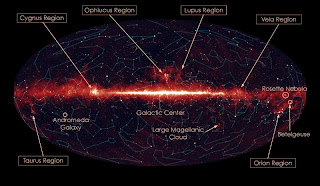
AKARI image of the Milky way center in IR
To avoid the earth's atmosphere, infrared observations have been made from high-flying aircraft, notably the Kuiper Airborne Observatory (KAO) and the new Stratospheric Observatory for Infrared Astronomy (SOFIA), from unmanned balloons, rockets, and from Earth-orbiting satellites. The Infrared Astronomical Satellite (IRAS) surveyed the entire sky at several infrared wavelengths cataloguing almost a quarter of a million objects.
More recently the Infrared Space Observatory (ISO) targeted over 30,000 astronomical objects for detailed study. There were several other early surveys, two of which were particularly note worthy: one from the ground, the 2 m Sky Survey by Gerry Neugebauer (1932– ) and Robert Leighton(1919–97), producing the IRC catalogue published in1969; and one using rockets, the Air Force Geophysics Laboratory survey by Steve Price and Russ Walker, producing the AFGL catalogue published in 1976.
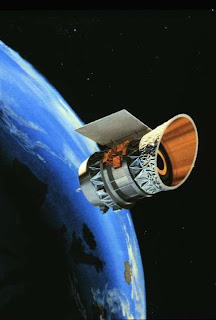
Infrared Astronomical Satellite (IRAS)
It was an international project involving the USA, the Netherlands and the UK. Its main objective was to make the first all sky infrared survey from space, searching for objects with temperatures between 10 and a few hundred kelvin. Its 60-cm (23-inch) reflecting telescope focused incoming radiation on to an array of 64 semiconductor detectors, which were cooled to 1.8 K by liquid helium.
IRAS was launched by a DELTA rocket from Vandenberg Air Force Base, California, on 1983 January 26. It was placed in a 900-km (560-mi) Sun-synchronous, circular orbit inclined at 99° to the equator. During the main survey in 1983, between early February and the end of August, most of the sky was observed twice.
The IRAS catalogue published in 1984 contained 245,000 infrared point sources, more than 100 times the number known before launch. Many discoveries were made both during and after the mission. Solar System discoveries included: six new comets, notably Comet "IRAS-ARAKI-ALCOCK"; huge invisible tails on "Comet Tempel 2" and other comets; several asteroids, including the unusual object 3200 PHAETHON; and bands in the ZODIACAL DUST. Dust shells, possibly related to planetary formation, were discovered around VEGA and several other stars.
Star formation regions in "Dark Nebula" were studied in great detail and many Protostars were discovered. The star "Betelgeuse" was found to have ejected three huge dust shells, and clouds of dust named infrared cirrus were discovered all over the sky. IRAS also studied the galactic centre in great detail. Beyond the Milky Way, IRAS observed that many galaxies are powerful emitters of infrared radiation and some of these, the StarBurst-Galaxy, emit much more infrared than visible light.
Star formation regions in "Dark Nebula" were studied in great detail and many Protostars were discovered. The star "Betelgeuse" was found to have ejected three huge dust shells, and clouds of dust named infrared cirrus were discovered all over the sky. IRAS also studied the galactic centre in great detail. Beyond the Milky Way, IRAS observed that many galaxies are powerful emitters of infrared radiation and some of these, the StarBurst-Galaxy, emit much more infrared than visible light.

The Entire Sky in Infrared Light (1983), a composite image assembled from six months worth of data from the Infrared Astronomical Satellite (IRAS). It shows nearly the entire sky.
The bright horizontal band is the plane of the Milky Way, with the center of the Galaxy located at the center of the picture.
Because of its proximity, the Milky Way dominates our view of the entire sky, as seen in this image.

Spitzer Space Telescope
The need of a better and powerful infrared observatory was rising, and when Spitzer was launched and firstly operated, it brought to scientists a new world of studying astronomy like they never did before, Spitzer is a NASA space telescope for infrared astronomy, which was launched on August 25, 2003, initially on a two-and-a-half-year mission. With its 0.85-m (33-inch) mirror, it was the largest infrared telescope ever launched into space. It carried instruments for imaging and spectroscopy in the wavelength range 3–180 mm.
To reduce the amount of coolant it needed to carry, the telescope was placed in an orbit around the Sun, trailing behind Earth. In this orbit, compared with being in orbit around Earth, it cooled more quickly and was less affected by Earth’s own infrared emission. The telescope was named in honor of Lyman Spitzer, Jr (1914–1997), a distinguished American astrophysicist, who was the first person to propose putting a large telescope in space. Initially it had been referred to as the Space Infrared Telescope Facility or SIRTF.

An image of the Cartwheel Galaxy formed by combining X-ray data from the Chandra X-ray Observatory, ultraviolet light from the Galaxy Evolution Explorer satellite, a visible image by the Hubble Space Telescope and an infrared view from the Spitzer Space Telescope.

M31 (Andromeda) in infrared light, showing evidence that the spiral galaxy was involved in a violent head-on collision(see Galaxy Collision) with the neighboring dwarf galaxy Messier 32 (M32) more than 200 million years ago. This infrared photograph taken with NASA's Spitzer Space Telescope revealed a never-before-seen dust ring deep within the Andromeda galaxy.

A Spitzer Space Telescope infrared image of the Ring Nebula (M57) gives a very different picture from the visible color one, bringing out lots of detail not seen at other wavelengths.
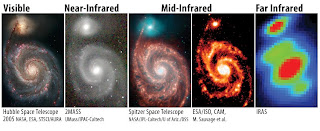
Visible, Near, Mid and Far Infrared comparison of M51 Spiral Galaxy
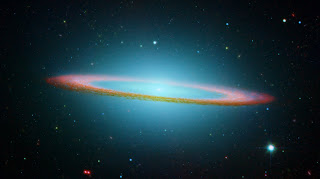
"M104 in IR"
This floating ring is the size of a galaxy. In fact, it is part of the photogenic Sombrero Galaxy, one of the largest galaxies in the nearby Virgo Cluster of Galaxies. The dark band of dust that obscures the mid-section of the Sombrero Galaxy in optical light actually glows brightly in infrared light. The above image shows the infrared glow, recently recorded by the orbiting Spitzer Space Telescope, superposed in false-color on an existing image taken by NASA's Hubble Space Telescope in optical light. The Sombrero Galaxy, also known as M104, spans about 50,000 light years across and lies 28 million light years away. M104 can be seen with a small telescope in the direction of the constellation of Virgo.
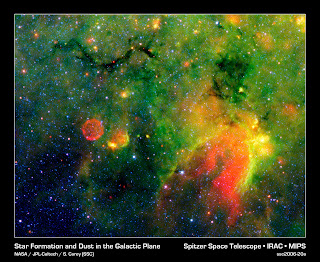
A Galactic Star Forming Region in Infrared, spans about 150 light years and lies about 10,000 light years away toward the constellation of Sagittarius, Spitzer Space Telescope
Related Article:
- Near Earth Objects Danger and Studies
- What are the types of galaxies
- When Giant Black Holes Collide
- What happens when galaxies collide?
- Gamma Ray Burst Danger and Studies
- Sunspot: Sharpest View Yet in Visible Light
- Binoculars in Astronomy
- Buying a Telescope for Beginners
Do you like this article? please "Share" and "Like" it to spread the benefit :)...












Amazing! Nice blog!
ReplyDelete